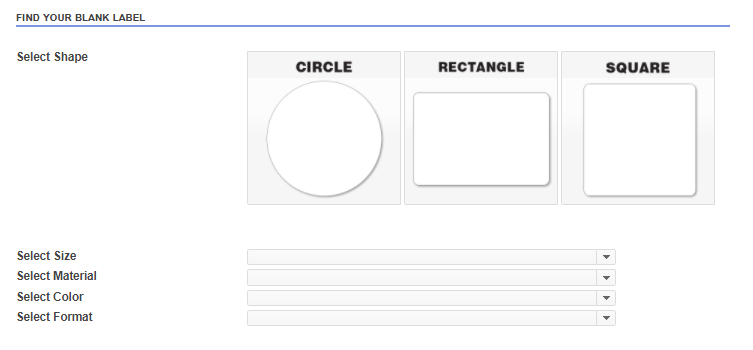Understanding Just How Blank Labels Work to Boost Your Labeling Experience
Recognizing the mechanics of blank labels is vital for maximizing your labeling techniques throughout numerous contexts. To fully grasp exactly how these labels can transform your processes, one should think about the various kinds readily available and the myriad ways they can be tailored to match certain demands.

Advantages of Utilizing Blank Labels
Blank labels use a versatile service for numerous identifying demands, making them vital in both personal and expert settings. Their versatility permits individuals to develop personalized labels customized to particular needs, enhancing business performance. Whether used in home workplaces, retail environments, or industrial applications, blank labels promote the recognition and categorization of products, records, and personal products.
One substantial advantage of blank labels is their cost-effectiveness. By allowing individuals to publish only the labels they need, waste is lessened, and supply monitoring becomes much more workable. Furthermore, blank labels work with numerous printing approaches, consisting of inkjet and laser printers, making them easily accessible for various customers.

Moreover, making use of blank labels streamlines the process of updating information, as individuals can conveniently print brand-new labels to change outdated ones, making sure that all items and files are precisely classified. In general, blank labels give a functional and reliable labeling service for diverse applications.
Kinds Of Blank Labels Available
What options are offered when it pertains to blank labels? Blank labels can be found in a variety of types, each fit for various applications and preferences. The most typical kinds consist of paper labels, which are versatile and affordable, making them suitable for day-to-day usage. They are available in various surfaces, such as matte and shiny, enabling aesthetic flexibility.
One more prominent choice is synthetic labels, commonly made from products like polyester or plastic. These labels are understood for their longevity and resistance to water, chemicals, and tearing, making them ideal for rough settings. They are generally made use of in commercial setups or for labeling products that might be revealed to dampness.
In addition, there are thermal transfer labels, which need a printer that utilizes warm to transfer ink onto the tag surface area. These labels are preferred for their top notch print and long life.
Lastly, specialized labels provide to certain requirements, such as removable labels for short-term use or high-temperature labels for severe problems. Comprehending these options allows users to pick one of the most proper blank label for their unique labeling demands.
Modification Options for Labels
A large range of customization alternatives is offered for labels, enabling individuals to tailor them to specific demands and branding demands. Users can pick from different sizes, forms, and products to make sure that the labels efficiently fit their designated objective. Common products consist of paper, polyester, and vinyl, each offering various levels of resilience and visual go charm.
Shade options play a crucial duty in personalization, enabling brands to keep consistency with their company identification. Individuals can select from a spectrum of shades or perhaps go with customized printing to match details branding aspects. websites In addition, labels can be printed with special designs, logo designs, and text, improving brand name recognition and aesthetic influence.
One more vital aspect is the option of adhesive. Tags can be designed with irreversible, removable, or repositionable adhesives, depending upon the application needs. This flexibility enables reliable labeling solutions throughout various environments, from retail to commercial setups.

Tips for Effective Labeling
Efficient labeling surpasses customization; it additionally includes tactical considerations that boost performance and communication. To achieve reliable labeling, begin by clearly specifying the function of each label. Take into consideration the details that needs to be conveyed and guarantee it is provided in a straightforward fashion. Utilizing succinct language and staying clear of jargon can dramatically enhance understanding.
Next, focus on visibility by picking proper colors and font styles. High contrast between message and background improves readability, while larger font styles promote quick recognition. Additionally, guarantee that labels are placed in a consistent and rational fashion, making it simpler for customers to locate and translate details.
Take into consideration the resilience of labels. Pick materials fit for the certain environment where the labels will be utilized, whether it be inside or outdoors. Waterproof or tear-resistant options may be essential depending on read here the context.
Lastly, regularly evaluation and upgrade your labels to mirror any kind of changes in information or usage. This positive technique not just keeps clarity but likewise stays clear of complication over time. By following these suggestions, you can make best use of the effectiveness of your labeling efforts, ensuring they serve their intended purpose efficiently.
Applications of Blank Labels
Blank labels provide many applications across different sectors, making them a vital tool for company and interaction. These versatile labels are typically used in warehouses for supply monitoring, permitting services to quickly recognize and track products. By applying blank labels to storage space containers, shelves, or pallets, business can improve their operations and decrease the possibility of errors.
In the medical care market, blank labels play an essential duty in identifying medications and clinical products, making sure proper recognition and use. Adjustable labels can include crucial details such as dosage, expiry days, and client information, improving safety and conformity.
In retail, blank labels help in rates products, providing promos, or identifying rack places, which ultimately boosts the client experience. They permit for quick updates to pricing or item information without the need for pre-printed labels.
In addition, blank labels are helpful for personal usage, such as organizing home workplaces, crafting, or labeling food containers. Their flexibility allows people to create customized solutions that satisfy particular requirements. Overall, the applications of blank labels are considerable, underscoring their value in fostering effectiveness and clarity in different setups.
Conclusion
In final thought, blank labels present a flexible and reliable service for numerous labeling requirements. Their flexibility in size, shape, and product permits for tailored applications across various settings. By leveraging customization options and efficient labeling approaches, organizations can enhance clearness and interaction (Blank Labels). Inevitably, the integration of blank labels into operational procedures adds to boosted efficiency, making them a vital source for both personal and professional use.